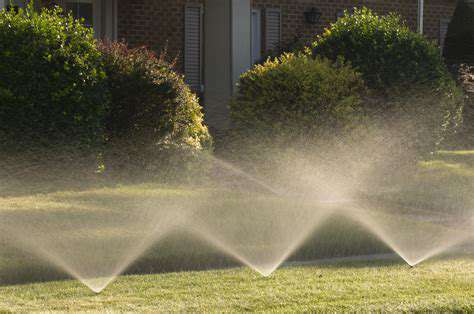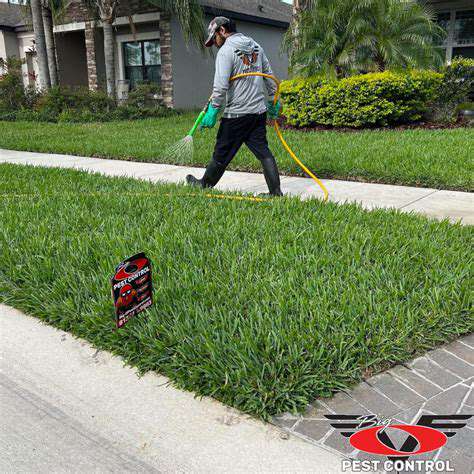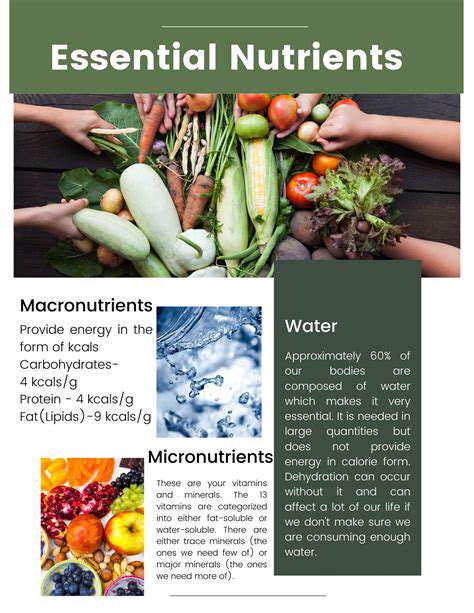How to Care for Your Lawn
Choosing the Right Grass Type for Your Climate and Needs
Understanding Your Climate
Climate plays a crucial role in determining which grass type will thrive in your yard. Factors like average temperature, rainfall, and humidity significantly impact grass growth and health. Researching the typical weather patterns in your region is the first step in selecting a suitable grass species. Different grasses have different tolerances for heat, cold, and drought, so understanding your local climate will help you avoid costly mistakes and ensure a vibrant lawn.
For example, warm-season grasses like Bermuda and Zoysia excel in hot, sunny climates, while cool-season grasses like Kentucky bluegrass and fescue perform better in cooler, more temperate regions. Knowing your climate's extremes, such as the hottest summer temperatures and the coldest winter temperatures, is essential for selecting a hardy and resilient grass type.
Considering Your Lawn's Needs
Beyond climate, consider your lawn's specific needs. Do you desire a low-maintenance lawn that requires minimal watering and mowing? Or, do you prefer a lush, vibrant lawn that demands more attention and care? Different grass types have varying levels of maintenance requirements. Some grasses need more frequent mowing, while others are more tolerant of infrequent mowing. The amount of sunlight your lawn receives also impacts your choice, as some grasses thrive in full sun, while others prefer partial shade.
Evaluating Sunlight Exposure
Sunlight exposure is a critical factor in selecting the right grass type. Different grass types have varying tolerance levels for sun exposure. Some grasses, like Kentucky bluegrass, thrive in full sun, while others, like shade-tolerant varieties, prefer shaded areas. Understanding the amount of sunlight your lawn receives will help you choose a grass type that can flourish in your specific conditions. Incorrect sunlight exposure can lead to yellowing, thinning, or even death of the grass.
Considering Soil Conditions
The quality of your soil also significantly influences your grass selection. Different grass types have different soil preferences. Some grasses thrive in well-drained soils, while others prefer moist, fertile soils. Conduct a soil test to determine your soil's pH level and nutrient content. Understanding your soil's characteristics will enable you to select a grass type that will thrive in your particular soil type. You may need to amend your soil to create optimal conditions for the grass you choose.
Exploring Different Grass Types
A wide variety of grass types are available, each with unique characteristics and benefits. Researching the different options, such as Kentucky bluegrass, fescue, Bermuda, Zoysia, and others, will help you make an informed decision. Consider factors like their growth rate, tolerance for foot traffic, and resistance to diseases and pests when making your selection. Each type has a different tolerance for foot traffic and different mowing requirements. For example, some types are better suited for high-traffic areas, while others are more suitable for residential lawns.
Maintenance Requirements
Different grass types have varying maintenance needs. Some require more frequent mowing, fertilization, and watering than others. Consider your lifestyle and available time when selecting a grass type. A grass type that requires less maintenance will save you time and effort in the long run. A grass that is well maintained will look better and stay healthier.
Budgetary Considerations
The cost of establishing and maintaining a lawn can vary depending on the grass type you choose. Some grass types are more expensive to purchase and install. Consider your budget when making your decision. Research the costs associated with seed, sod, or other installation methods. Also, factor in ongoing maintenance costs, such as fertilizers and pesticides. In the long run, a grass type that requires less maintenance can save you money.
Preparing Your Soil for Optimal Lawn Growth

Soil Testing and Analysis
A crucial first step in preparing your soil for optimal plant growth is conducting a soil test. This analysis provides valuable insights into the existing nutrient levels, pH, and other important characteristics of your soil. Understanding these factors allows you to tailor your fertilization and amendment strategies to meet the specific needs of your plants, ensuring they receive the ideal balance of nutrients for robust growth. A soil test can identify potential deficiencies or imbalances, allowing you to address them proactively. This prevents unnecessary spending on fertilizers and ensures your plants receive exactly what they need.
The results of a soil test will typically include information about pH levels, nutrient content (nitrogen, phosphorus, potassium, etc.), and organic matter levels. This data is essential for determining which amendments are necessary to bring your soil to optimal levels for your intended crops or landscaping projects. By accurately assessing your soil's current condition, you can create a targeted plan for improvement. This precision approach maximizes the effectiveness of your efforts and ensures your plants thrive.
Amendments for Improved Soil Structure
Adding organic matter is a fundamental aspect of soil preparation. Compost, manure, and other organic materials significantly improve soil structure, drainage, and aeration. These amendments enhance the soil's ability to retain water and nutrients, creating an environment that fosters healthy root development and overall plant growth. Organic matter also contributes to the overall health of the soil ecosystem by supporting beneficial microorganisms and improving soil structure, which is essential for successful plant growth.
Beyond organic matter, other amendments such as gypsum or lime may be necessary depending on the specific needs of your soil. Gypsum can help improve drainage and reduce soil compaction, while lime can help adjust the pH level to a range suitable for many plants. Careful consideration of these amendments ensures that your soil is not only fertile but also well-structured for optimal water retention and drainage, leading to healthier plants.
Preparing the Bed for Planting
After amending your soil, it's essential to prepare the planting bed. This involves tilling or loosening the soil to a suitable depth, ensuring proper aeration and drainage. This process also helps to incorporate the amendments evenly throughout the soil, maximizing their effectiveness. Proper soil preparation ensures that the roots of your plants can easily access the nutrients and water they need for optimal growth.
Removing any rocks, debris, or weeds is crucial at this stage. These elements can hinder root development and potentially compete with your plants for resources. A well-prepared planting bed provides a clean and optimal environment for your plants to flourish, ensuring their health and vigor. Thorough preparation is essential for establishing a strong foundation for healthy plant growth.
Watering and Maintaining Soil Moisture
Consistent watering is crucial for maintaining optimal soil moisture levels. This is especially important during the initial stages of plant growth, when young roots are developing and establishing themselves. Watering deeply and less frequently helps to encourage deep root systems, making your plants more resilient to drought conditions. Proper watering ensures your soil provides the necessary moisture for vital plant functions.
Regular monitoring of soil moisture is key to ensuring your plants receive the right amount of water. Sticking your finger into the soil or using a moisture meter can help you gauge how much water your plants need. This prevents overwatering, which can lead to root rot and other problems. By understanding how to effectively manage watering schedules, you can create a consistent environment that promotes healthy plant growth.
Watering Your Lawn Effectively and Efficiently

Optimizing Your Watering Schedule
Watering your lawn effectively isn't just about getting the job done; it's about doing it efficiently and sustainably. A well-planned watering schedule considers factors like your local climate, soil type, and the specific needs of your grass type. Understanding these variables allows you to tailor your watering routine to avoid overwatering, a common mistake that can lead to water waste and potentially damage your lawn. By adjusting your watering frequency and duration based on these factors, you can significantly reduce your water bill and promote healthier grass growth. Proper watering techniques are crucial for a thriving lawn, and a tailored schedule is key to achieving that.
Consider the time of day when you water. Watering during the hottest part of the day can lead to significant water loss through evaporation. Watering early in the morning or late in the evening minimizes this loss, allowing the water to be absorbed by the roots, thus promoting healthy growth and reducing the risk of fungal diseases. This is a simple but effective strategy for maximizing water use and promoting a healthy lawn.
Choosing the Right Watering Tools and Techniques
Selecting the right tools for the job is essential for effective lawn watering. Different tools cater to various needs and lawn sizes. A sprinkler system, for example, can provide consistent coverage across a larger area, but it requires careful setup and regular maintenance to avoid waste. On the other hand, a soaker hose or drip irrigation system targets water directly to the roots, minimizing evaporation and maximizing water absorption. Choosing the right tool is a crucial step in optimizing your watering strategy.
Beyond the tools, the techniques you employ matter greatly. Using a spray nozzle that directs water in a gentle stream, rather than a forceful spray, helps to reduce runoff and ensures that water penetrates the soil effectively. Also, consider the soil type in your yard. Sandy soil drains quickly, requiring more frequent watering, while clay soil retains water, necessitating less frequent watering. Knowing your soil type and adjusting your watering technique accordingly is vital to preventing water waste and promoting healthy root development.
Finally, always monitor your lawn. Look for signs of overwatering or underwatering, such as wilting or excessive dryness. Regular observation allows you to adjust your schedule and methods as needed. This proactive approach ensures your lawn consistently receives the right amount of water for optimal health.
Fertilizing and Pest Control for a Vibrant Lawn

Fertilizing Strategies
A well-nourished lawn is crucial for its health and aesthetic appeal. Proper fertilization, tailored to your specific grass type and soil conditions, is essential for promoting vigorous growth and a vibrant green color. Choosing the right fertilizer blend is vital, considering factors like nitrogen, phosphorus, and potassium content. Over-fertilizing can lead to detrimental effects, including burning the grass and harming beneficial soil organisms.
Different types of grass require different fertilizer needs. For example, cool-season grasses like Kentucky bluegrass and fescue typically benefit from fall fertilization to encourage root development before winter. Warm-season grasses, on the other hand, usually respond better to spring and summer fertilization to promote growth during the active growing season. Regular monitoring of your lawn's health is key to optimizing fertilization practices. This allows you to adjust your approach as needed, ensuring the best results without unnecessary expenses or environmental concerns.
Pest Control Methods
Managing pests is an integral part of maintaining a healthy lawn. Identifying the specific pests infesting your lawn is crucial for developing an effective control strategy. Invasive insects or diseases can quickly damage your lawn, leading to unsightly patches and reduced aesthetic appeal. Early detection and intervention are critical for preventing widespread infestations.
Several methods exist for pest control, ranging from natural remedies to chemical treatments. Natural methods like introducing beneficial insects or using organic pesticides can be effective and environmentally friendly. However, in some cases, chemical treatments might be necessary to control severe infestations. Carefully consider the potential risks and benefits of each method, consulting with a local gardening expert for personalized advice.
Importance of Regular Inspections
Regular inspections of your lawn are vital for proactive pest and disease management. Early detection allows you to address problems before they become significant, saving time and money. Thoroughly examining your lawn for signs of pest activity, such as visible insects, damage to leaves, or unusual discoloration, is essential. Regular inspection is a key aspect of preventative lawn care.
Monitoring your lawn's overall health, including checking for signs of stress or unusual growth patterns, is just as important. This can include looking for wilting, yellowing, or thinning patches. By promptly addressing these issues, you can prevent them from spreading and maintain a vibrant, healthy lawn. Proactive maintenance is far more cost-effective than trying to fix extensive damage.


![How to Use AI Tools for Studying Effectively [Ethics]](/static/images/31/2025-05/MitigatingPotentialEthicalConcernsAssociatedwithAIStudyTools.jpg)







